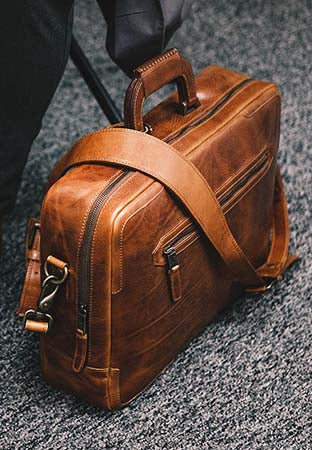Suede and nubuck leather are celebrated for their distinct textures and aesthetic appeal when designing leather goods like wallets, shoes, and other fashion items. However, both require regular maintenance to maintain their unique appearances.
From understanding their characteristics to care instructions, let’s explore the best practices for caring for suede and nubuck leather.
Understanding Suede and Nubuck
Both suede and nubuck leather sport individual properties that make them popular in the fashion industry. While they share some similarities, their texture, durability, and care differences set them apart.
Suede
- Suede is created from the inner layer of the animal hide.
- It is sanded down to produce its characteristic soft, fuzzy surface.
- This material is celebrated for its luxurious feel and flexibility, which allows for creating a wide array of fashion accessories.
- Due to its porous nature, suede is more susceptible to water damage and staining, necessitating regular maintenance and application of water/stain repellents to preserve its quality.
Nubuck
- Nubuck is crafted from the outer side of the hide (specifically the full-grain section), making it more durable than suede.
- It undergoes a buffing process to create a napped finish, which yields a thicker and more durable material than suede.
- Nubuck is suitable for items that require resilience, such as shoes and outerwear.
- Nubuck's breathability and aesthetic appeal also make it favorable for fashion items.
- Despite its robustness, nubuck is prone to scratches and requires attention to preserve its quality and appearance.
Suede Care Tips

The soft, porous nature of suede makes it susceptible to dirt and stain accumulation, necessitating regular maintenance. Here are some tips for keeping your suede items in top condition*.
(*If you’ve purchased your suede item from Will Leather Goods and aren’t happy with your results, contact us to speak with our leather experts.)
Regular Care of Suede
Engaging in a consistent care routine is essential to ensuring longevity and preserving suede's soft texture.
- Brushing: Use a soft-bristled suede brush to gently remove dust and debris. Brush in the direction of the fibers to avoid roughening the texture.
- Spot cleaning: For localized stains, use a suede eraser. Gently rub the eraser over the stain until it lifts. Avoid excessive force, which might damage the suede's nap.
Deep Cleaning Suede
This process rejuvenates the suede and helps maintain its luxurious texture and appearance.
- Preparing: Gently brush the suede with a soft-bristled brush to remove surface dirt and dust. This step exposes the fibers and prepares the leather for cleaning.
- Applying: Choose a cleaner* specifically designed for suede. Suede shampoos or foam cleaners are recommended because they're formulated to clean without damaging the delicate fibers. Follow the product instructions carefully. Typically, you’ll apply a small amount to a damp cloth or sponge, then gently work it into the leather in a circular motion.
- Wiping: If the product requires rinsing, gently remove any soap residue using a clean, damp cloth. Do not saturate the suede, as too much water can cause staining.
- Drying: Gently pat the suede with a dry towel to remove excess moisture. Allow it to air dry naturally away from direct heat or sunlight, which can fade and damage the suede.
- Restoring: Once the suede is dry, use a suede brush to lift the nap and restore its natural texture.
*Before applying any cleaning solution, conduct a patch test on a less visible section to ensure it doesn't affect the material.
Conditioning Suede
Due to its delicate texture, conditioning suede requires a careful approach.
- Suede conditioner: Choose a spray conditioner made for suede to lightly coat the surface without altering its appearance or feel.
- Clean: Follow the steps above to clean the suede item thoroughly and ensure it is dry.
- Apply: Spray the conditioner evenly from approximately 6 inches away, covering the entire surface. Avoid saturating the leather.
- Dry: Allow the suede to dry naturally (away from heat sources) to prevent damage.
Protecting Suede
Given suede's susceptibility to water and stain damage, applying a protective layer is important for maintaining its condition.
- Water and stain repellent: Select a protectant spray labeled for suede. These products are formulated to create a barrier that repels water, oil, and stains while preserving the leather's natural texture.
- Apply: With a clean and dry suede item (see the steps above), apply the protectant spray evenly, holding the bottle 6 inches from the surface.
- Dry: Dry in a well-ventilated area.
- Periodically reapply: Reapply as needed to maintain optimal protection, especially with regular use or exposure to harsh conditions.
Managing Spills and Stains on Suede
Quick responses are key to handling spills and stains on suede to prevent permanent damage.
- Take immediate action: At the first sign of a spill, gently blot the excess liquid with a clean, dry cloth. Avoid rubbing, as this can push the spill deeper into the suede or cause the stain to spread.
- If it’s water: Allow the suede to air dry naturally. Do not use heat, as it can cause the suede to harden or shrink.
- If it’s oil: Apply talcum powder or cornstarch on the affected area to help absorb the oil. Leave it overnight, then gently brush off the powder with a suede brush.
- If it’s ink: Ink stains are more challenging and may require a suede eraser or a specialized stain remover. Gently dab (do not rub) the stain with the eraser or apply the remover according to its instructions.
- Targeted treatments: For persistent or tough stains, consider a targeted suede cleaner. Test the cleaner on an inconspicuous area first to ensure it won’t affect the color or texture. Apply as directed and allow the suede to air dry.
- Deeper stains: Consider professional cleaning services for deep or persistent stains to restore your item's beauty without risking damage.
Storing Suede
You can preserve the look and feel of your suede items by maintaining their shape, protecting them from moisture, and shielding them from sunlight.
- Store to maintain shape: To prevent deformation, store suede items in a way that maintains their shape. Use shoe trees for suede shoes and padded hangers for jackets and other apparel. Stuffing smaller items like bags or accessories with soft paper can help preserve their form.
- Avoid humidity and moisture: Store your suede goods in a cool, dry place. Silica gel packets can be placed in the storage area to help absorb any excess moisture.
- Avoid sunlight exposure: When storing suede, keep it away from direct sunlight. Prolonged exposure to sunlight can cause the suede's color to fade, the material to dry out, and the suede to become brittle.
- Use breathable covers: Opt for breathable fabric bags or coverings (like cotton) when storing suede items. Avoid plastic bags since they trap moisture.
Nubuck Care Tips

While nubuck is similar to suede in its plushness, it requires its own care practices* due to its finer texture and greater durability.
(*If you are dissatisfied with the cleaning results of your Will Leather Goods nubuck item, please contact us for assistance.)
Regular Care of Nubuck
Maintaining the quality and appearance of nubuck requires care with the right tools and techniques.
- Brushing: Opt for a nubuck brush, which typically features softer bristles than those used for suede. Gentle, circular motions with the brush can help maintain the material's even texture.
- Spot cleaning: A nubuck cleaning block (or eraser) is effective for spots. Gently rub the block over the stain until it fades, being careful not to flatten or damage the nap.
Deep Cleaning Nubuck
Deep-cleaning nubuck enhances its appearance and extends its lifespan by removing deep-seated dirt and restoring its natural texture.
- Preparing: Brush the nubuck with a nubuck brush to eliminate surface dirt. A nubuck cloth can also pick up dust and light grime.
- Applying: Use a nubuck-specific cleaner*, usually available as a spray or foam. Spray a small amount onto a clean cloth or sponge, then lightly dab or stroke the nubuck. Avoid direct application to prevent oversaturation.
- Rinsing: Lightly dampen another cloth with water to remove any leftover cleaner from the nubuck. Ensure the cloth is damp to avoid water stains.
- Drying: Press a dry microfiber cloth against the cleaned area to absorb moisture, then allow the nubuck to air dry thoroughly in a well-ventilated area away from direct heat.
- Restoring: Once dry, use a nubuck brush to gently buff the surface, reviving the nap to its original softness and texture.
*Always test any cleaning product on a small, inconspicuous area first to ensure it won’t alter the color or texture of the leather.
Conditioning Nubuck
The unique nap and texture of nubuck require a specialized conditioner designed for this particular leather type.
- Nubuck conditioner: A spray conditioner intended for nubuck best hydrates the leather without compromising its look or feel.
- Apply: Ensure the nubuck is clean and completely dry before application (see steps above). Spray the conditioner uniformly across the surface, maintaining a distance of 6 inches, and avoid over-saturating.
- Dry: Allow the nubuck to air dry away from direct heat to avoid damage.
Protecting Nubuck
Protection is important for nubuck to shield it from elements that can mar its appearance or cause lasting damage.
- Water and stain repellent: Use a protectant specifically made for nubuck to shield against water, oil, and other potential stains while maintaining the leather’s texture.
- Apply: With the nubuck item clean and dry (see above), evenly distribute the protectant spray, keeping the bottle 6 inches away from the leather.
- Dry: Allow it to dry in an area with good air circulation.
- Periodically reapply: Regular reapplication is advised for consistent protection, particularly for frequent-use items or those exposed to adverse environmental conditions.
Managing Spills and Tough Stains on Nubuck
By treating spills promptly and using targeted cleaning methods, you can maintain the appearance and integrity of nubuck leather.
- Take immediate action: If the nubuck encounters a spill, promptly blot the area with a clean, dry cloth. This action helps to prevent the spill from setting into the leather.
- If it’s water: If the nubuck gets wet, allow it to air dry. Keep it away from direct heat sources to avoid altering the texture or shape of the leather.
- If it’s oil: Sprinkle talcum powder or cornstarch on oil spills to absorb the substance. Let it sit overnight or for several hours, then brush it off with a nubuck brush.
- If it’s ink: For ink stains, a nubuck eraser designed for such marks can be effective. Use gentle motions to lift the stain.
- Targeted treatments: For deep-set stains, use a nubuck-specific cleaner. Always follow the product’s instructions carefully and test it on a less visible part of the item first. After cleaning, allow the nubuck to dry naturally.
- Deeper stains: Consider professional cleaning services for deep or persistent stains to restore your item's beauty without risking damage.
Storing Nubuck
These storage techniques safeguard your nubuck items against common factors that can change their quality and appearance.
- Store to maintain shape: Nubuck items should be stored in a manner that supports their natural shape. Utilize shoe trees, and padded hangers, and fill bags or other soft goods with tissue paper to avoid creasing and deformation.
- Avoid humidity and moisture: Nubuck is susceptible to damage from high humidity levels. Ensure the storage environment is dry, and consider using dehumidifiers or silica gel packets to combat moisture in the air.
- Avoid sunlight exposure: Store nubuck items away from direct sunlight to prevent fading and drying. Even indirect sunlight can lead to discoloration and weakening of the nubuck.
- Use breathable covers: To store nubuck goods, use breathable covers made from natural fabrics. This allows air circulation and prevents moisture buildup.
When to Seek Professional Cleaning Services

While regular home care can maintain the condition of suede and nubuck leather goods, there are circumstances where the expertise of leather experts becomes invaluable.
- Stubborn stains: If you've attempted home remedies without success, professional cleaners can offer specialized techniques and products that are more effective against tough stains without damaging the delicate leather.
- After accidents: In the event of significant spills, especially those involving liquids that can cause staining or damage beyond surface level (like oils, wines, or inks), it’s advisable to turn to a professional. They can address the spill thoroughly, preventing long-lasting harm.
- Visible wear and tear: Over time, suede and nubuck may show signs of wear, including discoloration, fading, or even minor damage. Professional services can rejuvenate these materials, restoring their color and texture.
For more leather care information, read our other guides:
- Step-by-Step Guide to Cleaning Fine Leather Goods
- Eco-Friendly Leather Care Products and Practices
- Vegan Leather vs. Traditional Leather: Care Differences
Preserving the Elegance of Suede and Nubuck
Whether you manage the upkeep yourself or enlist professional services for more challenging issues, the effort you put into caring for your suede and nubuck items will pay dividends in their sustained beauty and performance. Remember, taking proactive steps today preserves the timeless appeal of your suede and nubuck tomorrow.











